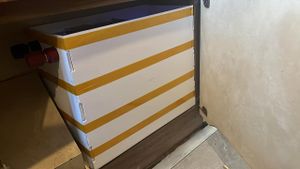House Batteries
There’s one main specification you’re looking for in house batteries: amp hours. A single amp hour represents, you guessed it, one amp of power, for one hour.
Amp hours are always given in terms of full capacity. But it’s important to note that different ways of storing power — different chemistries — carry different *usable* amp hour capacity. Good old reliable lead-acid has been with us since the 1850s … and though lead acid is still the best solution in some situations, like in providing the high current required for a cold start of a motor, its age shows. Lead acid batteries lose capacity if they’re completely discharged, and aren’t happy when they’re fully charged either. Because of these limitations, a lead acid battery has a *usable* capacity of 50 or 60 percent of its rated capacity. Absorbed Glass Mat (AGM) and Gel batteries are improvements to the original flooded wet-cell technology, which had a water and sulfuric acid solution sloshing around between lead plates, but the basic chemistry, and most performance properties, are similar.
Enter lithium. The undisputed king of battery tech -- for house batteries -- in 2021 is lithium; specifically LifePo4. With a competent battery management system, LP4 is good for thousands of charge/discharge cycles, and the batteries store much more power in the same amount of space as lead acid, and are lighter weight to boot. If you’re patient and have moderate mechanical skills, a LifePo4 battery bank can be acquired for less than the cost of equivalent storage in lead acid cells.
Shoot for 280 amp-hours
Capacity is, of course, dependent on your loads and your sources. Most GMC roofs can easily accommodate 450-500 watts of solar without compromise. We'll assume that air conditioning is out of the question, though experimentation (and another GMCMHWiki entry) is encouraged. And we'll assume you want to be able to run a modern 12 volt compressor refrigerator or the 12 volt section of a propane refrigerator (control section, not a resistive load), run lighting and entertainment devices (ideally all 12 volt), and use an inverter to power 15 amps AC (hair dryer, microwave, etc.) for less than an hour total each day. Given that, 280 amp hours of capacity is a good choice.
Buy it prepackaged, or package it yourself?

One benefit of the DIY approach to assembling LifePo4 cells is that the configuration can be anything you want it to be. Cells are typically 3.2 volts each, and arranged in a series of 4 become a 12.8 volt battery, perfectly compatible with your house electric system. Importantly, they do not need to be arranged in a particular way, though they should be sandwiched in some way so that any internal pressure is vented through their engineered vents rather than expansion and contraction of their aluminum shell. Typical 280ah cells are 175mm (~6 7/8") wide by 72mm (2 7/8") thick by 205 mm (8 1/16") high. And they can be assembled in any orientation or arrangements, as freely as a set of building blocks. That means, for instance, that you can arrange them in a 'briefcase' configuration of 14" wide by 6" thick and make a battery that fits well in that little afterthought of a closet door under the electrical space in many GMCs. You want to house LifePo4 batteries inside, by the way, because they're more sensitive to temperature than vintage lead-acid tech. If you're comfortable, they're comfortable.
NOTE: LiFePO4 batteries cannot be recharged when they are below freezing temperature. Be sure your battery's Battery Monitoring System (BMS) has a cold battery charging disconnect. Some batteries are rated for cold weather charging. They have an internal heater which will use the available charging current to warm the battery to above freezing before applying the charge current to the cells.
So, for the sake of comparison, let's look at various decision factors for 280 amp hours of storage.
| Description | volume | weight | cost | life | maintenance | origin | notes |
|---|---|---|---|---|---|---|---|
| Trojan J305E-AC Lead Acid | 79,990cc
4880ci |
152kg
332lbs |
$1,200 | rated 600 cycles | must be watered, trickle fed, stored for winter | USA | 2 needed for 12v; Trojan rates life only for 50% depth of discharge; for 280 usable amp hours at 12 volts, you need 4 batteries |
| DIY LifePo4 from AliExpress | 10,330cc
630.5ci |
21kg
46.5lbs |
~$520 w/BMS | 3000 cycles | Must be stored for winter | China | Cheapest option by far; see Will Prowse videos on YouTube. Can be configured to fit odd spaces. |
| LiitoKala LifePo4 | 15,655cc
955.3ci |
25kg
55lbs |
~$625 | 3000 cycles | Must be stored for winter | China | Good option with warranty, though vendor is halfway around the world. |
| Battle Born LifePo4 | 40,476cc
2,470ci |
36.9kg
81.4lbs |
~$2,250 | 3000 cycles | Must be stored for winter | Assembled USA; Chinese parts | Rated by Battle Born for 270ah |